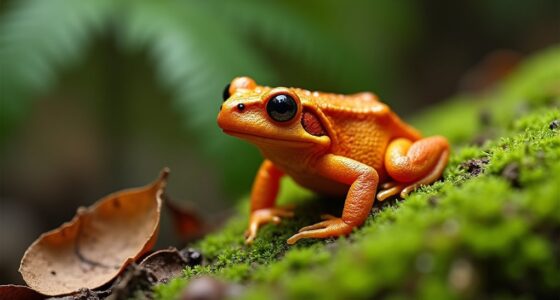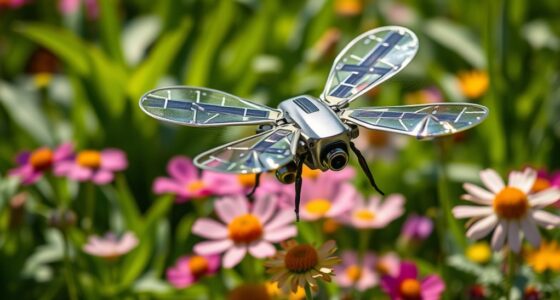To make your backyard wildlife-friendly, plant native trees, shrubs, and flowers that bloom year-round to provide food and shelter for birds, bees, and butterflies. Add water sources like birdbaths or small fountains, and include habitat features such as brush piles and logs for nesting and hiding spots. These simple but effective steps create a thriving ecosystem, attracting a diverse range of species. Keep exploring to discover more ways to enhance your backyard’s natural charm.
Key Takeaways
- Plant native trees, shrubs, and flowers to provide consistent food and habitat for local wildlife throughout the year.
- Incorporate seasonal blooming native plants to ensure continuous nectar, pollen, and seed sources for pollinators.
- Provide fresh, shaded water sources like birdbaths or fountains with safe landing spots for drinking and bathing.
- Add habitat features such as brush piles, logs, and flower-rich borders to offer nesting and hiding spaces.
- Promote a balanced ecosystem by combining native plantings and water sources to attract diverse birds, bees, and butterflies.

Creating a wildlife-friendly backyard doesn’t have to be complicated. You can start by focusing on simple, effective changes that attract birds, bees, butterflies, and other pollinators. One of the most impactful steps is planting native species. Native plantings are vital because they provide familiar food sources and habitats for local wildlife. When you choose plants that naturally thrive in your region, you create an environment where insects and birds can find nectar, seeds, and shelter without extra effort. Incorporate a variety of native trees, shrubs, and flowering plants that bloom throughout the seasons to guarantee there’s always something for wildlife to enjoy. This diversity keeps your backyard lively and helps sustain the local ecosystem.
Another key aspect is providing water sources. Wildlife needs accessible water for drinking and bathing, especially during hot, dry periods when natural sources may be scarce. You don’t need a fancy pond; even a shallow birdbath or a small, gently flowing fountain can make a big difference. Keep these water sources clean and filled regularly, and consider placing them in shaded areas to prevent mosquito breeding and make them more inviting. Adding stones or shallow ledges can give small creatures a safe spot to land or enter the water easily. Providing accessible water sources encourages more frequent visits from birds, butterflies, and other creatures. Creating habitat features like brush piles, logs, or flower-rich borders also enhances your backyard’s appeal. These elements support nesting, hiding, and foraging opportunities, giving wildlife safe spaces away from predators and human disturbance. Including native vegetation further enhances habitat quality by offering natural shelter and food. When you combine native plantings with water sources, you set up a mini ecosystem that naturally attracts a wide range of species. You’ll notice more birds visiting your feeders, bees buzzing around, and butterflies fluttering through.
Frequently Asked Questions
How Can I Attract Specific Native Species to My Yard?
You can attract specific native species by choosing native plant selection that provides essential food and shelter. Plant a variety of native flowers, shrubs, and trees to support different species. Additionally, create bird nesting sites by offering natural or artificial nesting boxes, especially in quiet, sheltered areas. Keep your yard pesticide-free to protect wildlife. These steps will encourage targeted native species to visit and thrive in your yard.
What Plants Are Best for Supporting Pollinators Year-Round?
To support pollinators year-round, focus on native plant selection with seasonal bloom strategies. Choose plants that bloom at different times, like early crocuses, summer coneflowers, and late asters, ensuring nectar and pollen availability throughout the year. Native plants are best because pollinators are adapted to them, making your yard a essential resource. Mix flowering trees, shrubs, and perennials to create a continuous, inviting habitat for bees, butterflies, and other pollinators year-round.
Are There Safe Ways to Discourage Invasive Wildlife?
Thinking of playing wildlife bouncer? It’s possible with native plant selection and habitat restoration. You can gently discourage invasive species by planting native plants that outcompete them and creating habitats that favor local wildlife. No need for traps or poisons—just strategic planting and habitat tweaks. This way, you maintain a balanced ecosystem, helping native species thrive while keeping invasive unwelcome guests at bay. Nature’s best bouncers are native plants!
How Do I Create a Natural Water Source for Wildlife?
To create a natural water source for wildlife, you should choose a spot that offers natural filtration, like rocks or gravel, to keep the water clean. Incorporate water flow options such as a gentle fountain or a small stream to prevent stagnation and attract animals. Guarantee the water is shallow and accessible, and clean it regularly to maintain freshness. This setup encourages birds, bees, and other creatures to visit safely.
What Precautions Should I Take to Avoid Attracting Pests?
To prevent pests from being attracted to your wildlife-friendly water source, focus on pest prevention strategies and wildlife barriers. Regularly clean and change the water to reduce mosquito breeding and remove debris that attracts pests. Use wildlife barriers like screens or netting to keep pests away from the water source. Keep the area tidy and avoid overfeeding wildlife, which can inadvertently draw unwanted pests. These steps help protect both wildlife and your yard.
Conclusion
By turning your backyard into a vibrant oasis, you’re planting seeds of hope for birds, bees, and other creatures. Think of your space as a sanctuary—a lively symphony where every flower, feeder, and nest is a note in nature’s melody. With each small effort, you become a guardian of life’s delicate balance, creating a haven where wildlife can flourish and thrive. Your backyard isn’t just a patch of land; it’s a thriving heartbeat of the wild.










